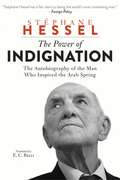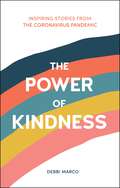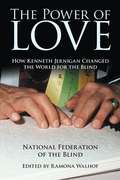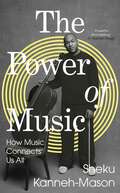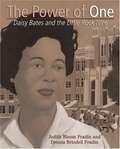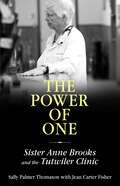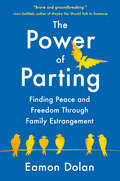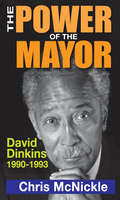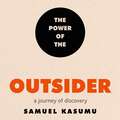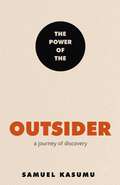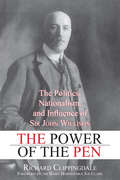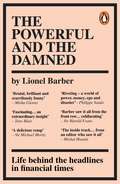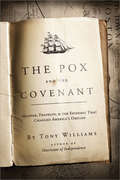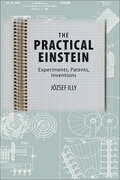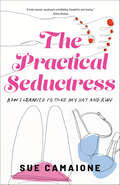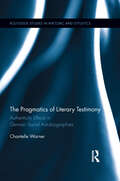- Table View
- List View
The Power of Ideas: Words of Faith and Wisdom
by Jonathan SacksBritain's most authentically prophetic voice - The Daily Telegraph'The choice with which humankind is faced is between the idea of power and the power of ideas.'From his appointment as Chief Rabbi in 1991, through to his death in November 2020, Rabbi Lord Jonathan Sacks made an incalculable contribution not just to the religious life of the Jewish community but to the national conversation - and increasingly to the global community - on issues of ethics and morality.Commemorating the first anniversary of his death, this volume brings together a compelling selection of Jonathan Sacks' BBC Radio Thought for the Day broadcasts, Credo columns from The Times, and a range of articles published in the world's most respected newspapers, along with his House of Lords speeches and keynote lectures.First heard and read in many different contexts, these pieces demonstrate with striking coherence the developing power of Sacks' ideas, on faith and philosophy alike. In each instance he brings to bear deep insights into the immediate situation at the time - and yet it as if we hear him speaking to us afresh, giving us new strength to face the challenges and complexities of today's world.These words of faith and wisdom shine as a beacon of enduring light in an increasingly conflicted cultural climate, and prove the timeless nature and continued relevance of Jonathan Sacks' thought and teachings.One of the great moral thinkers of our time - Robert D. Putnam, author of Bowling Alone
The Power of Indignation: The Autobiography Of The Man Who Inspired The Arab Spring
by Stéphane Hessel E. C. BelliThe astonishing life of the writer named by the New York Times "one of the last living heroes of the darkest era of the twentieth century."His brief pamphlet Indignez-vous! (Cry Out!) is an international bestseller, calling for a return to the values of his native France's "greatest generation," the resistance fighters of World War II. It has inspired citizens participating in the Arab Spring and Occupy Wall Street uprisings. Now Stéphane Hessel, one of France's preeminent thinkers and activists, is back.With extraordinary insight, the ninety-four-year-old Hessel gives his intellectual autobiography. His thinking is nourished by the exchange he has maintained for years with his close friends, as well as prominent political and literary figures: Edgar Morin, Jean-Paul Dollé, Daniel Cohn-Bendit, Régis Debray, Peter Sloterdijk, Laure Adler, Michel Rocard, and Jean-Claude Carrière.This book is accessible and profound-it is for all those who seek, despite the contradictions and violence of our contemporary lives, to "regain our dignity as men and women while governed by a frenzy of selfish and irresponsible people." This book is, for Stéphane Hessel, a way to encourage us to reflect on the past in order to take charge of our future destiny. At once a handbook for the revolutionary, a treatise on human rights, and an inside look at the relationships, thoughts, and recollections of one of the most important figures in France, this is not-to-be-missed.
The Power of Kindness: Inspiring Stories, Heart-Warming Tales and Random Acts of Kindness from the Coronavirus Pandemic
by Debbi MarcoKindness mattersWhen times are hard, we pull together. Despite the difficulties of life during the coronavirus pandemic, love and kindness prevail.Dive into this heart-warming book and discover the many uplifting and inspiring acts of kindness that have come from the crisis. Read about the postman who donned fancy dress while doing his rounds to bring a smile to his community, the mum who set up a virtual story time for young children, or the schools that worked together to manufacture face masks for local care homes and hospitals.The coronavirus crisis may be a challenging time for the world, but the amazing stories in this book show that nobody is too small to make a difference – and that, no matter what, we can always find light in the darkness.
The Power of Love: How Kenneth Jernigan Changed the World for the Blind
by National Federation of the Blind<P>The Power of Love: How Kenneth Jernigan Changed the World for the Blind shares the voices of a collection of individuals whose writings reveal the deep truth that serves as the foundation for the life and work of Kenneth Jernigan. <P>His life and their writings together speak of how Thomas Jefferson's self-evident truths imply that equality extends to embrace blind people just as surely as this country has come to understand equality's inclusion of all people regardless of the color of their skin. <P>Ramona Walhof, editor of The Power of Love and longtime friend of Kenneth Jernigan, draws together the distinctive voices of individuals who knew Kenneth Jernigan and whose lives he touched through his work with the National Federation of the Blind. Each of the reflections begins with a brief biographical sketch that introduces the chapter's author and ties his or her life to Kenneth Jernigan and his work. <P>The book concludes with a chapter, "Blindness: The Federation at Fifty," a retrospective written by Kenneth Jernigan himself in the last decade of his life. The Power of Love: How Kenneth Jernigan Changed the World for the Blind gathers a polyphonic chorus of voices that tell how the power of love, coursing through the life of Kenneth Jernigan, changed the world for the blind and, in so doing, changed the world for everyone.
The Power of Love: The Royal Wedding Sermon
by Bishop Michael CurryThe text of the celebrated 2018 royal wedding sermon, plus four other sermons touching on themes of love, commitment, and social justice, by Bishop Michael CurryTwo billion people watched Bishop Michael Curry deliver his sermon on the redemptive power of love at the royal wedding of Prince Harry and Meghan Markle (now the Duke and Duchess of Sussex) at Windsor Castle in May 2018. Here, he shares the full text of that sermon, plus an introduction describing the context, along with four of his favourite sermons on the themes of love and social justice. The world met Bishop Curry at the wedding and was moved by his riveting, hopeful, and deceptively simple message: love and acceptance are what we need in these strange times.
The Power of Music: A celebration of how music connects us all, from the internationally-renowned young musician
by Sheku Kanneh-Mason'Sheku believes that the future of classical music is bright, and in the hands of young musicians like him, it certainly is’ John SuchetMusic is what makes us alive, mindful and connected to each other. Music is what makes us human. This is the power of music.Cellist Sheku Kanneh-Mason knows and feels the transformative power of music as much as any musician alive. From winning the prestigious BBC Young Musician Award to performing at Harry and Meghan’s wedding; from Bach’s solo suites to Bob Marley’s reggae; his ferocious passion shines through in every single performance, whether in a packed-out concert hall or on record.But how was it that someone like him – a person of colour, from a state school in Nottingham – rose to the upper echelons of the classical music world? What were the obstacles that he had to overcome, what did he learn along the way, and how could a young person follow in his footsteps today?In The Power of Music, Sheku explores the experiences and values that led him here, from a childhood of football practice and family music sessions, to his work today in the world’s finest concert halls and in the less privileged communities that surround them. As his star continues to rise, he shows us the darker side of an industry ruled by exclusivity and stubborn adherence to tradition.With its power to transform our mental and physical health, to effect social change, and to make a house a home, Sheku shows us that classical music is for everyone, not just an elite few. The Power of Music is a celebration of music of all sorts and those who make it, and a rallying call to change.‘A heartfelt plea for the importance of excellence in music performance and education, from one of the leading role models of our time' Sir Nicholas Kenyon, former director of the BBC Proms and Barbican Centre'Powerful and inspiring' Sir Stephen Hough
The Power of One
by Judith Bloom Fradin Dennis Brindell FradinAs a child growing up in Arkansas, Daisy Bates experienced segregation in restaurants, parks, and stores. At school, she and her classmates were crowded into poorly equipped rooms and deprived of the quality of education their white neighbors enjoyed. The practice of forcing African Americans to use separate, often inferior, facilities was an accepted way of life in many parts of the United States.
The Power of One: Sister Anne Brooks and the Tutwiler Clinic (Willie Morris Books in Memoir and Biography)
by Sally Palmer ThomasonFor thirty-four years Sister Anne Brooks, a Catholic nun and doctor of osteopathy, served one of the nation’s most impoverished towns and regions, Tutwiler, in Tallahatchie County in the Mississippi Delta. In 1983, she reopened the Tutwiler Clinic, which had remained closed for five years, as no other physician was willing to serve in Tallahatchie County. Starting with only two other nuns and regularly working twelve-hour days, Brooks’s patient load—in a region where seven out of ten patients that walked in her door had no way to pay for care—grew from thirty to forty individuals per month her first year to more than 8,500 annually. Sally Palmer Thomason tells the powerful story of Sister Anne Brooks, beginning with her tumultuous childhood, the contracting and overcoming of crippling arthritis in early adulthood, and her near-unprecedented decision to attend medical school at the age of forty. Dr. Brooks’s remarkable dedication and accomplishments in caring for the health and well-being of both the individuals and the community of Tutwiler attracted ongoing attention and was often featured in national publications and media, including People magazine and 60 Minutes. Thomason not only shares Brooks’s powerful story but reveals, through excerpts from journal entries, letters, and interviews, the intimate musings that connect Brooks’s faith in God to her profound compassion for others. Whether it is Brooks’s efforts to desegregate Tutwiler or provide free healthcare, her constant devotion to others is striking.
The Power of Parting: Finding Peace and Freedom Through Family Estrangement
by Eamon DolanA myth-shattering, inspiring book that combines research, reportage, and memoir to explore the growing phenomenon of estrangement from toxic relatives—showing it not as a tragedy, but as an empowering and effective solution to the heartbreak of family abuse.After decades of enduring his mother&’s physical and psychological torment, after years of trying in vain to set boundaries, Eamon Dolan took a radical step: he cut his mother out of his life. No more phone calls, no more visits, no more contact. Parting with his abuser gave him immediate relief and set him on a path toward freedom, confidence, and joy like none he had ever felt before.In The Power of Parting, Dolan has written the book he wishes he&’d had when he was struggling to free himself from his mother&’s abuse. In the process, he discovered how widespread estrangement really is. At least 27 percent of Americans are estranged from a parent, sibling, or other family member. He also learned why so much stigma surrounds this common—and often lifesaving—phenomenon. Even among therapists—the professionals who would seem most attuned to the pain relatives can inflict—there&’s a bias toward reconciliation, when millions of their patients need instead to escape their abusers&’ grip. Estrangement, Dolan realized, should be understood and embraced, not shrouded in shame.Drawing on his own suffering and healing, as well as experts&’ advice and the testimony of other courageous survivors, Dolan first explains why abuse is much different and more prevalent than we may think, how it harms us in childhood and beyond, and why limiting or eliminating contact might be our best possible choice. Then, he walks readers through the steps of a successful, positive estrangement: how to take crucial time for yourself; how to make sure no one can gaslight you into minimizing or forgetting; how to set rules for your abuser and—if they can&’t or won&’t respect your limits—how to end a toxic relationship. He also offers valuable counsel on how to ease the guilt and grief that often accompany parting, and how to break the cycle of abuse that was likely passed down to you through many generations.With a convincing blend of clarity and empathy, Dolan encourages others to do what he ultimately did for himself: determine whether the people in your life treat you with the care and concern you deserve—and part ways with them if they don&’t.
The Power of Protest: A Visual History of the Moments That Changed the World
by Brenda GriffingA combination of current events and proud history, The Power of Protest reviews all of the protests that have shaped our society, as well as those at work RIGHT NOW at reshaping the system. Includes beautiful photography alongside current resources for you to continue to fight the injustices that remain in our culture — The Power of Protest will inspire you to be the change you wish to see in the world! Times of great change did not occur by man's desire for change. They were fought for, battled into being, through protest and persistence. As we continue to push for justice, rights we now take for granted were born through protests like those we are waging today. The true impact of activism may not be felt for a generation but that alone is a reason to fight rather than forfeit our freedoms. Looking to our history, the peoples history, we can see how society was shaped by those citizens who refused to give up. How do we want to pick up their mantle? Organized by cause, in an oversized package with photographs and timelines that chronicles protests throughout our global history — you'll find information on modern movements that you can get involved in, the stories and origins of those causes, as well as inspirational quotes from leaders and scholars throughout. Activists and those interested in activism can read about the fight for equal rights of all races, all sexes, all genders...and explore how their cause has shaped the world. What did the journey look like from the women's right to vote to modern feminism? What was the path taken by race activists as they changed history, from abolitionists to black lives matter? This visual history covers all aspects of protests that shaped our society, including: The Fight for Women's Rights The Fight for Race Rights The Fight for Gay (LGBTQ+) Rights The Fight for Peace & Freedom The Fight for Worker's Rights Specific modern causes such as Gun Violence (responses and protests from Columbine to Parkland) and more... As Margaret Mead said, "Never doubt that a small group of thoughtful, committed citizens can change the world. Indeed, it's the only thing that ever has."
The Power of Rare: A Blueprint for a Medical Revolution
by Victoria Jackson Dr Michael Yeaman"The Power of Rare is equal parts science and inspiration. In her urgent drive to help her daughter, Victoria Jackson not only transformed the competitive world of biomedical research, but also created a new medical model for generations to come." —Arianna HuffingtonVictoria Jackson revolutionized the beauty industry in the 1980s and '90s with her "no make-up" approach to make-up and ultimately made Victoria Jackson Cosmetics into a billion-dollar global brand. But her greatest test of the power of rare didn't come until her daughter, Ali, was diagnosed with neuromyelitis optica, or NMO—a rare, life-threatening autoimmune disease—and Victoria, driven by a mother's love, set out to find a cure for her daughter. Within days of hearing Ali's diagnosis in 2008, Victoria began the Guthy-Jackson Charitable Foundation to fund medical research into this often misdiagnosed orphan disease. Her "blueprint" called for breaking down the so-called silos of traditional medical research and bringing together some of the greatest minds to collaborate and share their findings. She hadn't expected to galvanize how medical research works, but within only a few years, that's just what she did. By focusing on the "rare" in each of us, the foundation has catalyzed breakthroughs in NMO in record time. These advances are also opening new doors to solving MS, lupus, and other autoimmune diseases—plus diseases that are not so rare, including cancer, infection, aging, and more. It has been Victoria's guiding philosophy that if she can do it, anyone can. With The Power of Rare, she shares how the foundation harnessed the power of rare to speed discoveries that help patients. Through her business savvy, wit, and heart, she offers real-world advice and inspiration for others to tap into "rare" to empower their own breakthroughs.
The Power of Things Unseen: Tales of Choosing Crazy Over Normal
by Leanne R. WoodThe Power of Things Unseen tells a riveting true story about a woman whose inner voice leads her on an enthralling and nerve-racking journey, pursuing what is written in her heart. Chock-full of tales combining raw emotion, unbridled humor, and miraculous intervention, she regales the reader with her exploits as an aid worker in post-communist Romania and as a business entrepreneur in the USA. It takes courage to follow your gut, buck the “right way” of doing things, and step out into the unknown, but it is only then that you can really live to your full potential. This compelling narrative of a young mother who takes an intuitive path with almost no resources will inspire you to follow your own inner voice and unleash The Power of Things Unseen.
The Power of Women: A doctor's journey of hope and healing
by Dr Denis Mukwege'These women are each a light and an inspiration, demonstrating how the best instincts of humanity - to love, to share, to protect others - can triumph in the worst possible circumstances.'Nobel laureate, world-renowned doctor and human rights activist, Dr Mukwege has dedicated his life to caring for victims of sexual violence. Over the past two decades living and working in the Democratic Republic of the Congo, he has stood up to soldiers and warlords, survived massacres and multiple assassination attempts, never swaying from his mission.In this book Dr Mukwege interweaves his own dramatic story with the experiences of a range of extraordinary characters: the women he has treated - many of whom, after suffering unspeakable brutality, have had the strength to heal and rebuild their lives - as well as the people he has worked with, and survivors of sexual violence whom he has met during his years of advocating for women's rights around the world.Early on in his career, Dr Mukwege realised what he was dealing with in the DRC was merely the extreme end of a global scourge. Sexual violence is the most common, under-reported and least prosecuted crime in the world. It does not occur in a vacuum. We are all implicated - whether the violence occurs in war-torn countries, or on college campuses in the West.The Power of Women is a rallying cry to rid our societies of violence against women, and to better learn from their resilience, strength and power. It challenges us to think about our own experiences and howall of us have a part to play in bringing about change.For Dr Mukwege, 'emotion without action' is meaningless. Read this book and say 'no' to indifference.
The Power of a Plant: A Teacher's Odyssey to Grow Healthy Minds and Schools
by Suzie Boss Stephen RitzIn The Power of a Plant, globally acclaimed teacher and self-proclaimed CEO (Chief Eternal Optimist) Stephen Ritz shows you how, in one of the nation’s poorest communities, his students thrive in school and in life by growing, cooking, eating, and sharing the bounty of their green classroom.What if we taught students that they have as much potential as a seed? That in the right conditions, they can grow into something great?These are the questions that Stephen Ritz—who became a teacher more than 30 years ago—sought to answer in 2004 in a South Bronx high school plagued by rampant crime and a dismal graduation rate. After what can only be defined as a cosmic experience when a flower broke up a fight in his classroom, he saw a way to start tackling his school’s problems: plants. He flipped his curriculum to integrate gardening as an entry point for all learning and inadvertently created an international phenomenon. As Ritz likes to say, “Fifty thousand pounds of vegetables later, my favorite crop is organically grown citizens who are growing and eating themselves into good health and amazing opportunities.”The Power of a Plant tells the story of a green teacher from the Bronx who let one idea germinate into a movement and changed his students’ lives by learning alongside them. Since greening his curriculum, Ritz has seen near-perfect attendance and graduation rates, dramatically increased passing rates on state exams, and behavioral incidents slashed in half. In the poorest congressional district in America, he has helped create 2,200 local jobs and built farms and gardens while changing landscapes and mindsets for residents, students, and colleagues. Along the way, Ritz lost more than 100 pounds by eating the food that he and his students grow in school. The Power of a Plant is his story of hope, resilience, regeneration, and optimism.
The Power of the Mayor: David Dinkins: 1990-1993
by Chris McNickleChris McNickle argues that New York City Mayor David Dinkins failed to wield the power of the mayor with the skill required to run the city. His Tammany clubhouse heritage and liberal political philosophy made him the wrong man for the time. His deliberate style of decision-making left the government he led lacking in direction. His courtly demeanor and formal personal style alienated him from the people he served while the multi-racial coalition he forged as New York's first African-American mayor weakened over time.Dinkins did have a number of successes. He balanced four budgets and avoided a fiscal takeover by the unelected New York State Financial Control Board. Major crime dropped 14 percent and murders fell by more than 12 percent. Dinkins helped initiate important structural changes to the ungovernable school system he inherited. His administration reconfigured health care for the poor and improved access to medical treatment for impoverished New Yorkers.McNickle argues that David Dinkins has received less credit than he is due for his successes because they were overshadowed by his failure to fulfill his promise to guide the city to racial harmony. This stimulating review of a transitional period in New York City's history offers perspective on what it takes to lead and govern.
The Power of the Outsider: A Journey of Discovery
by Samuel KasumuA fascinating investigation into the value of difference and an inspiring blueprint for outsiders everywhere.Samuel Kasumu was the most senior black advisor in Boris Johnson's government, until he left in April 2021. Throughout his time in Whitehall, Samuel became increasingly aware that he was an outsider - that his own experiences, assumptions and language were so different to many of those he found himself surrounded by in Downing Street.In this audiobook Samuel considers who outsiders are, why they are not talked about enough and how it can be a source of strength that leads them to become high achievers. He argues that the success of many great people can be explained by their outsider status.Drawing on his own experiences in government, growing up and beyond, as well as the stories of other outsiders, famous and lesser known, Samuel shows how outsiders are more likely to be trailblazers and break barriers, how they have a greater sense of perspective and progress and how our differences can be a force for good - in politics and beyond.(P) 2023 Hodder & Stoughton Limited
The Power of the Outsider: A Journey of Discovery
by Samuel Kasumu'Samuel Kasumu has written an important - and very moving - book about the outsider phenomenon.' - Robert Peston' I loved reading about your childhood and your anxieties as a father. The personal is so well mixed with the analytical. Thank you for reflecting our experiences and ideas so well and so sensitively. This is really great to read!' - Kadie Kanneh-MasonSamuel Kasumu was the most senior black advisor in Boris Johnson's government, until he left in April 2021. Throughout his time in Whitehall, Samuel became increasingly aware that he was an outsider - that his own experiences, assumptions and language were so different to many of those he found himself surrounded by in Downing Street.In this book Samuel considers who outsiders are, why they are not talked about enough and how it can be a source of strength that leads them to become high achievers. He argues that the success of many great people can be explained by their outsider status.Drawing on his own experiences in government, growing up and beyond, as well as the stories of other outsiders, famous and lesser known, Samuel shows how outsiders are more likely to be trailblazers and break barriers, how they have a greater sense of perspective and progress and how our differences can be a force for good - in politics and beyond.
The Power of the Outsider: A Journey of Discovery
by Samuel Kasumu'Samuel Kasumu has written an important - and very moving - book about the outsider phenomenon.' - Robert Peston' I loved reading about your childhood and your anxieties as a father. The personal is so well mixed with the analytical. Thank you for reflecting our experiences and ideas so well and so sensitively. This is really great to read!' - Kadie Kanneh-MasonSamuel Kasumu was the most senior black advisor in Boris Johnson's government, until he left in April 2021. Throughout his time in Whitehall, Samuel became increasingly aware that he was an outsider - that his own experiences, assumptions and language were so different to many of those he found himself surrounded by in Downing Street.In this book Samuel considers who outsiders are, why they are not talked about enough and how it can be a source of strength that leads them to become high achievers. He argues that the success of many great people can be explained by their outsider status.Drawing on his own experiences in government, growing up and beyond, as well as the stories of other outsiders, famous and lesser known, Samuel shows how outsiders are more likely to be trailblazers and break barriers, how they have a greater sense of perspective and progress and how our differences can be a force for good - in politics and beyond.
The Power of the Pen: The Politics, Nationalism, and Influence of Sir John Willison
by Richard Clippingdale Right Honourable Joe ClarkArguably, Sir John Willison had more influence on the evolution of Canada’s emerging nationalism and public policy shifts than any other journalist had in his time or since. Sir John Willison (1856-1927) was the most influential Canadian journalist in the late 19th and early 20th centuries while the country achieved economic growth, intellectual maturation, and world status. With his incisive pen and clear reasoning, Willison utilized Toronto’s Globe and News, his Times of London contributions, his many books and speeches, and his unparalleled connections with key political leaders to establish himself as a major national figure.Uniquely, Willison was at the heart of both the Liberal and Conservative Parties as a devoted supporter and good friend of Sir Wilfrid Laurier; a first employer, early booster, and continual admirer of William Lyon Mackenzie King; and a close ally of Sir Robert Borden. Willison was a major player in the epochal federal political shifts of 1896, 1911, and 1917 and articulated highly influential views on the nature and evolution of Canadian nationalism and public policy.
The Powerful and the Damned: Private Diaries in Turbulent Times
by Lionel Barber'Extraordinary' TONY BLAIR'Riveting' - PHILIPPE SANDS'Brutal, brilliant and scurrilously funny' - MISHA GLENNYThe real scoop isn't on the front page'As FT editor, I was a privileged interlocutor to people in power around the world, each offering unique insights into high-level decision-making and political calculation, often in moments of crisis. These diaries offer snapshots of leadership in an age of upheaval...'Lionel Barber was Editor of the Financial Times for the tech boom, the global financial crisis, the rise of China, Brexit, and mainstream media's fight for survival in the age of fake news.In this unparalleled, no-holds-barred diary of life behind the headlines, he reveals the private meetings and exchanges with political leaders on the eve of referendums, the conversations with billionaire bankers facing economic meltdown, exchanges with Silicon Valley tech gurus and pleas from foreign emissaries desperate for inside knowledge, all against the backdrop of a wildly shifting media landscape.The result is a fascinating - and at times scathing - portrait of power in our modern age; who has it, what it takes and what drives the men and women with the world at their feet. Featuring close encounters with Trump, Cameron, Blair, Putin, Merkel and Mohammed Bin Salman and many more, this is a rare portrait of the people who continue to shape our world and who quite literally, make the news.
The Pox Lover: An Activist's Decade in New York and Paris
by Anne-Christine D'Adesky<P>The Pox Lover is a personal history of the turbulent 1990s in New York City and Paris by a pioneering American AIDS journalist, lesbian activist, and daughter of French-Haitian elites. In an account that is by turns searing, hectic, and funny, Anne-christine d'Adesky remembers "the poxed generation" of AIDS—their lives, their battles, and their determination to find love and make art in the heartbreaking years before lifesaving protease drugs arrived. <P>D'Adesky takes us through a fast-changing East Village: squatter protests and civil disobedience lead to all-night drag and art-dance parties, the fun-loving Lesbian Avengers organize dyke marches, and the protest group ACT UP stages public funerals. Traveling as a journalist to Paris, an insomniac d'Adesky trolls the Seine, encountering waves of exiles fleeing violence in the Balkans, Haiti, and Rwanda. <P>As the last of the French Nazis stand trial and the new National Front rises in the polls, d'Adesky digs into her aristocratic family's roots in Vichy France and colonial Haiti. This is a testament with a message for every generation: grab at life and love, connect with others, fight for justice, keep despair at bay, and remember.
The Pox and the Covenant
by Tony WilliamsFor one hundred years, God had held to his promise, and the colonists had as well. When the first Puritans sailed into Massachusetts in the seventeenth century, weak from the ocean journey, they formed a covenant with each other and with God to establish a city on a hill-a commitment to live uncorrupted lives together or all suffer divine wrath for their collective sin. But now, a century later, the arrival of one doomed ship would put this covenant to its greatest test. On April 22, 1721, the HMS Seahorse arrived in Boston from the West Indies, carrying goods, cargo, and, unbeknownst to its crew, a deadly virus. Soon, a smallpox epidemic had broken out in Boston, causing hundreds of deaths and panic across the city. The clergy, including the famed Cotton Mather, turned to their standard form of defense against disease: fasting and prayer. But a new theory was also being offered to the public by the scientific world: inoculation. The fierce debate over the right way to combat the tragedy would become a battle between faith and reason, one that would set the city aflame with rage and riot. The Pox and the Covenant is a story of well known figures such as Cotton Mather, James Franklin, and a young Benjamin Franklin struggling to fight for their cause among death and debate-although not always for the side one would expect. In the end, the incredible results of the epidemic and battle would reshape the colonists' view of their destiny, setting for America a new course, a new covenant, and the first drumbeats of revolution.
The Practical Einstein: Experiments, Patents, Inventions
by József IllyThis unique biography of the famous theoretical physicist explores his work in the practical worlds of technology, engineering and experimental physics.Albert Einstein is known as the whacky genius behind the theory of relativity, but that’s just one facet of his contribution to modern science and human knowledge. As József Illy demonstrates in this book, Einstein had an eminently practical side as well.As a youth, Einstein was an inveterate tinkerer in the electrical supply factory owned by his father and uncle. His first paid job was as a patent examiner. He consulted on industrial patent cases and worked on technological innovations, most notably the gyrocompass. Later in life, Einstein contributed to many inventions, including refrigerators, microphones, and instruments for aviation. His published papers often provided ways to test his theories, and he also wrote explanations for common natural phenomena, such as the meandering of rivers.In these and other hands-on examples culled from the Einstein Papers, Illy demonstrates how Einstein enjoyed leaving the abstract world of theories to wrestle with the problems of everyday life.A Choice Magazine Outstanding Academic Title
The Practical Seductress: How I Learned to Take My Hat and Run
by Sue CamaioneIn this sexually charged memoir, Sue Camaione sets off on a rebellious course to make her way as a young woman determined to live on her own terms despite societal mores. Full of a precocious curiosity about sexuality, Sue questions her religious education, challenges her school dress code, sets herself on a quest to lose her virginity, and, as she grows older, encounters challenges that at times leave her broke, sick, and homeless. She flees upstate New York, embarking on romantic adventures across the country. She discovers orgasmic joy in the Rocky Mountains, falls in love in Tucson, struggles with open marriage in San Diego, and explores forbidden intimacy in the arms of a Chilean graduate student in Boston. These experiences, men, places, and friendships transform her. Both a coming-of-age story and a depiction of an era, The Practical Seductress exposes the gender double standard and the dangers and joys of sexual freedom that defined the 1970s and ’80s. Filled with humor and learned wisdom, this is a story of desire and survival, navigating treacherous and unpredictable paths, defying social norms, and finding redemption.
The Pragmatics of Literary Testimony: Authenticity Effects in German Social Autobiographies (Routledge Studies in Rhetoric and Stylistics #4)
by Chantelle WarnerIn this book, Warner examines a number of German-language literary autobiographies that are connected to diverse social movements of the last forty years. These books have all received critical attention from the popular press, topped bestseller lists, and have been pivotal in discussions of authenticity, subjectivity, and referentiality. Because of the thematic diversity of these works, scholars within literary and cultural studies have tended to treat them separately under topical categories, such as women’s literature, the post-war generation, migration and multiculturalism, etc. Underlying Warner’s analysis is the belief that the social construction of autobiographical acts is as much a matter of textuality as it is of topicality i.e., how language means, rather than what it means, and that a pragmatic-stylistic approach is well-suited to describing how literary autobiographies come to function as testimonies to certain collective experiences. By presenting a model for an integrative stylistics approach, The Prgamatics of Literary Testimony participates in current discussions within fields of literary linguistic scholarship, as well as autobiographical theory. In its analysis of key examples of German social testimonies from the late twentieth century, this book incorporates insights from discourse analysis, pragmatics, cogntive poetics, and sociolinguistics in order to demonstrate that this diverse body of works constitutes a particular form of textual practice defined by what the author calls authenticity effects—feelings of realism, immediacy, exemplarity, genuineness, and social relevance. Such a study of authenticity as a poetic effect, can help us to better understand the testimonial glamour owned by various types of autobiographical narration.

